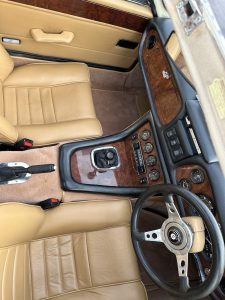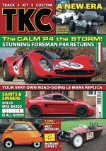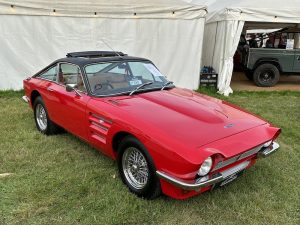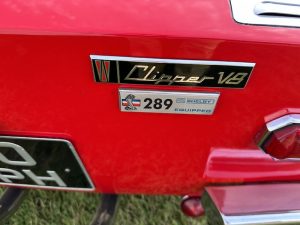THE STORY OF TRIDENT CARS
STEVE HOLE TELLS THE STORY OF TRIDENT CARS – Images by Carol Hardy
The original Trident was a model for TVR, with styling by Trevor Fiore (original name Frost). It was built by Italian styling house, Carrozzeria Fissore
TVR, owned at that time by Grantura Plastics, run by Arnold Burton, had gone into liquidation and Bill Last of Viking Performance, a TVR dealer, for the East Anglia area (Woodbridge, later Ipswich) and familiar to the specialist car scene, purchased the last of three Trident prototypes (a convertible), with the intention of productionising it. Last also produced tuned engines for Elva, for a time.
However, he commissioned Trevor Fiore to come up with a Trident 2+2 Fastback, which was 5in longer and 2½in wider than the intended TVR version. It was this car that he offered in fully built and kit form, although Bill quickly fell out with Fissore.
Although the Trident was one of the prettiest cars of its day, the company folded in 1974, caused in no small part by the American emission regulations that strangled exports there, the sort of red tape that did for Marcos amongst others
The company was revived in 1976 under Bill Last’s Viking Performance fibreglass division, albeit on a smaller scale, with plans for a Chrysler 360ci V8-powered Venturer with big rubber bumpers aimed at the US market. It was launched at the London Motor Show but it soon died again.
A real case of should have been huge. Another tale of a British marque that didn’t quite make it.
TRIDENT VENTURER
The sixties Trident operation aimed high and people often forget that the cars were available in kit form.
Productionised by Viking Performance and Trident Cars boss, Bill Last, originally based on Austin Healey 3000 chassis but soon switched to a stretched Triumph TR6 frame. Power came from a Ford Essex V6 from the Capri 3-litre.
It cost from £3398.85, plus a not inconsiderable £851.59 in purchase tax.
Magazine tests in Motor and Car didn’t really like the Venturer. They complained about the steering and the fact it overheated for fun. A Venturer did take on the London-to-Sydney World Cup rally although retired in Yugoslavia after the driver, Christopher Marriott entered under the 17th/21st Lancers team banner, hit a rock!
Trident Cars 1969-74
Approx 50 made
TRIDENT TYCOON
Trident Tycoon not only used Triumph TR6 chassis but its engine too and had revised Venturer styling. It featured a three-speed automatic gearbox.
Trident Cars 1971-73
Approx 6 made
TRIDENT CLIPPER

Another British specialist manufacturer of the sixties who should have – and almost did – made it. Luxurious interior
Frank Costin did a design for a ‘P5 Trident’ prototype although Trevor Fiore did the production version. It was originally based on Austin Healey 3000 mechanicals and chassis although Sankey soon began producing a bespoke chassis for the car.
Power was later changed to a Ford 289ci 4.7-litre V8 (basically a Mustang engine) that produced 270bhp and then later for the Mk3 version a Chrysler 5.4-litre V8 delivering 300bhp.
Last had acquired thirty 289ci V8 engines at a discount after they were ordered but not paid for by TVR, who had gone into receivership.
I’ve seen it written in period reports that a Clipper was the height of luxury for its time, especially when you consider that it was built by a tiny company.
A Clipper kit cost £1923 in kit form which was more than the cost of a Jaguar E-type with a 4.2-litre XK straight-six. In fully built guise prices started at around £3500, pricey when you consider a few hundred quid more would you buy a decent house in the UK!
Trident Cars 1972-1973
Approx 39 made
POSTSCRIPT:
At the Motor Show of October 1998, a company called PB Design, run by Phil Bevan relaunched the Trident marque with a new model called the Ventura.
By 2002 Bevan had moved on and another new Trident was launched by Bill Chubb and former Lola founder, Eric Broadley, trading as Broadley Performance Vehicles with a new model called the Iceni, initially with V8 power but later with an electric motor, with the company based in Fakenham, Norfolk. This operation ceased to be in 2004. I drove that car and indeed, it was featured in the launch issue (May 2001) of a magazine called Sportscar that I founded with my friend Martin Foster.
Phil Bevan reappeared later in 2004 with another new attempt at Trident resurrection with Trident Performance Vehicles and talk of developing the electric version and also a diesel, although they seem to have stopped trading 2008.
In September 2012, out of the blue, Phil Bevan returned again with a new business partner, Dan Monaghan, with essentially a revised Iceni/Ventura model powered by a 6.6-litre turbodiesel that produced 430bhp and could run on bio-diesel. They launched the car at the Salon Privé event in London, with admission tickets costing £246. The Iceni had a price tag of £70,000 with the Trident Sports Cars operation based in Swaffham, Norfolk.
None of the nineties/noughties Tridents were available in kit form.
| Print article | This entry was posted by admin on September 14, 2023 at 2:28 pm, and is filed under Uncategorized. Follow any responses to this post through RSS 2.0. Both comments and pings are currently closed. |
Comments are closed.

















